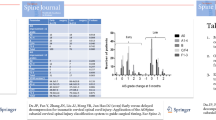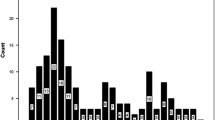Abstract
Purpose
This study aims to assess the nerve function deficient recovery in surgically treated patients with cervical trauma with spinal cord injury (SCI) in chronic stage and figure out prognostic predictors of improvement in impairment and function.
Methods
We reviewed the clinical and radiological data of 143 cervical SCI patients in chronic stage and divided into non-operative group (n = 61) and operative group (n = 82). The severity of neurological involvement was assessed using the ASIA motor score (AMS) and Functional Independence Measure Motor Score (FIM MS). The health-related quality of life was measured using the SF-36 questionnaire. Correspondence between the clinical and radiological findings and the neurological outcome was investigated.
Results
At 2-year follow-up, surgery resulted in greater improvement in AMS and FIM MS than non-operative group. Regression analysis revealed that lower initial AMS (P = 0.000), longer duration after injury (P = 0.022) and injury above C4 level (P = 0.022) were factors predictive of lower final AMS. Longer duration (P = 0.020) and injury above C4 level (P = 0.010) were associated with a lower FIM MS. SF-36 scores were significantly lower in higher age (P = 0.015), female patients (P = 0.009) and patients with longer duration (P = 0.001).
Conclusion
It is reasonable to consider surgical decompression in patients with cervical SCI in chronic stage and persistent spinal cord compression and/or gross cervical instability. Initial AMS, longer duration, injury above C4 level, higher age and female patients are the five major relevant factors of functional recovery.
Similar content being viewed by others
References
Lenehan B, Fisher CG, Vaccaro A, Fehlings M, Aarabi B, Dvorak MF (2010) The urgency of surgical decompression in acute central cord injuries with spondylosis and without instability. Spine 35:S180-186. https://doi.org/10.1097/BRS.0b013e3181f32a44
Guest J, Eleraky MA, Apostolides PJ, Dickman CA, Sonntag VK (2002) Traumatic central cord syndrome: results of surgical management. J Neurosurg 97:25–32. https://doi.org/10.3171/spi.2002.97.1.0025
Chen L, Yang H, Yang T, Xu Y, Bao Z, Tang T (2009) Effectiveness of surgical treatment for traumatic central cord syndrome. J Neurosurg Spine 10:3–8. https://doi.org/10.3171/2008.9.spi0822
La Rosa G, Conti A, Cardali S, Cacciola F, Tomasello F (2004) Does early decompression improve neurological outcome of spinal cord injured patients? appraisal of the literature using a meta-analytical approach. Spinal Cord 42:503–512. https://doi.org/10.1038/sj.sc.3101627
Umerani MS, Abbas A, Sharif S (2014) Clinical outcome in patients with early versus delayed decompression in cervical spine trauma. Asian Spine J 8:427–434. https://doi.org/10.4184/asj.2014.8.4.427
Mattei TA (2012) Surgical decompression after spinal cord injury: the earlier, the better! World Neurosurg 78:384–387. https://doi.org/10.1016/j.wneu.2012.09.004
Fehlings MG, Rabin D, Sears W, Cadotte DW, Aarabi B (2010) Current practice in the timing of surgical intervention in spinal cord injury. Spine 35:S166-173. https://doi.org/10.1097/BRS.0b013e3181f386f6
Park MS, Moon SH, Lee HM, Kim TH, Oh JK, Suh BK, Lee SJ, Riew KD (2015) Delayed surgical intervention in central cord syndrome with cervical stenosis. Glob Spine J 5:69–72. https://doi.org/10.1055/s-0034-1395785
Dvorak MF, Noonan VK, Fallah N, Fisher CG, Finkelstein J, Kwon BK, Rivers CS, Ahn H, Paquet J, Tsai EC, Townson A, Attabib N, Bailey CS, Christie SD, Drew B, Fourney DR, Fox R, Hurlbert RJ, Johnson MG, Linassi AG, Parent S, Fehlings MG (2015) The influence of time from injury to surgery on motor recovery and length of hospital stay in acute traumatic spinal cord injury: an observational Canadian cohort study. J Neurotrauma 32:645–654. https://doi.org/10.1089/neu.2014.3632
Stevens EA, Marsh R, Wilson JA, Sweasey TA, Branch CL Jr, Powers AK (2010) A review of surgical intervention in the setting of traumatic central cord syndrome. Spine J Off J North Am Spine Soc 10:874–880. https://doi.org/10.1016/j.spinee.2010.07.388
Yoshihara H, Yoneoka D (2013) Trends in the treatment for traumatic central cord syndrome without bone injury in the United States from 2000 to 2009. J Trauma Acute Care Surg 75:453–458. https://doi.org/10.1097/TA.0b013e31829cfd7f
Samuel AM, Bohl DD, Basques BA, Diaz-Collado PJ, Lukasiewicz AM, Webb ML, Grauer JN (2015) Analysis of delays to surgery for cervical spinal cord injuries. Spine 40:992–1000. https://doi.org/10.1097/brs.0000000000000883
Xu W (2014) Violence against doctors in China. Lancet (London, England) 384:745. https://doi.org/10.1016/s0140-6736(14)61438-0
Huang SL, Ding XY (2011) Violence against Chinese health-care workers. Lancet (London, England) 377:1747. https://doi.org/10.1016/s0140-6736(11)60732-0
Carlson GD, Gorden CD, Oliff HS, Pillai JJ, LaManna JC (2003) Sustained spinal cord compression: part I: time-dependent effect on long-term pathophysiology. J Bone Jt Surg Am 85:86–94
Dvorak MF, Fisher CG, Hoekema J, Boyd M, Noonan V, Wing PC, Kwon BK (2005) Factors predicting motor recovery and functional outcome after traumatic central cord syndrome: a long-term follow-up. Spine 30:2303–2311. https://doi.org/10.1097/01.brs.0000182304.35949.11
Kaminski L, Cordemans V, Cernat E, M’Bra KI, Mac-Thiong JM (2017) Functional outcome prediction after traumatic spinal cord injury based on acute clinical factors. J Neurotrauma 34:2027–2033. https://doi.org/10.1089/neu.2016.4955
Montoto-Marqués A, Trillo-Dono N, Ferreiro-Velasco ME, Salvador-de la Barrera S, Rodriguez-Sotillo A, Mourelo-Fariña M, Galeiras-Vázquez R, Meijide-Failde R (2018) Risks factors of mechanical ventilation in acute traumatic cervical spinal cord injured patients. Spinal Cord 56:206–211. https://doi.org/10.1038/s41393-017-0005-7
Vidal PM, Karadimas SK, Ulndreaj A, Laliberte AM, Tetreault L, Forner S, Wang J, Foltz WD, Fehlings MG (2017) Delayed decompression exacerbates ischemia-reperfusion injury in cervical compressive myelopathy. JCI Insight. https://doi.org/10.1172/jci.insight.92512
Baker PN, van der Meulen JH, Lewsey J, Gregg PJ (2007) The role of pain and function in determining patient satisfaction after total knee replacement. Data from the national joint registry for England and Wales. J Bone Jt Surg Br 89:893–900. https://doi.org/10.1302/0301-620x.89b7.19091
Shabat S, Folman Y, Arinzon Z, Adunsky A, Catz A, Gepstein R (2005) Gender differences as an influence on patients’ satisfaction rates in spinal surgery of elderly patients. Euro Spine J Off Publ Euro Spine Soc Euro Spinal Deform Soc Euro Sect Cerv Spine Res Soc 14:1027–1032. https://doi.org/10.1007/s00586-004-0808-z
Jansson KA, Németh G, Granath F, Jönsson B, Blomqvist P (2009) Health-related quality of life (EQ-5D) before and one year after surgery for lumbar spinal stenosis. J Bone Jt Surg Br 91:210–216. https://doi.org/10.1302/0301-620x.91b2.21119
Elsamadicy AA, Reddy GB, Nayar G, Sergesketter A, Zakare-Fagbamila R, Karikari IO, Gottfried ON (2017) Impact of gender disparities on short-term and long-term patient reported outcomes and satisfaction measures after elective lumbar spine surgery: a single institutional study of 384 patients. World Neurosurg 107:952–958. https://doi.org/10.1016/j.wneu.2017.07.082
Burström K, Johannesson M, Diderichsen F (2001) Health-related quality of life by disease and socio-economic group in the general population in Sweden. Health Policy (Amsterdam, Netherlands) 55:51–69. https://doi.org/10.1016/s0168-8510(00)00111-1
Author information
Authors and Affiliations
Corresponding authors
Ethics declarations
Conflict of interest
The authors declare that they have no conflicts of interest.
Additional information
Publisher's Note
Springer Nature remains neutral with regard to jurisdictional claims in published maps and institutional affiliations.
Rights and permissions
About this article
Cite this article
Ji, C., Rong, Y., Jia, H. et al. Surgical outcome and risk factors for cervical spinal cord injury patients in chronic stage: a 2-year follow-up study. Eur Spine J 30, 1495–1500 (2021). https://doi.org/10.1007/s00586-020-06703-1
Received:
Revised:
Accepted:
Published:
Issue Date:
DOI: https://doi.org/10.1007/s00586-020-06703-1




